The Future of Work: Changing Values in a Multi-Generational Workforce
Strength lies in differences, not in similarities.
– Stephen R. Covey, author of The 7 Habits of Highly Effective People
Changing demographics worldwide are creating a labor market in which five generations coexist. For the first time in history, the silent generation, baby boomers, Generation X, millennials, and Generation Z are working side by side. With more generations in the workforce than ever before, the workplace values and working styles are changing. Understanding this multigenerational workforce and its implications will be essential for driving innovation, creating united and productive teams, and adapting to the future workplace.
To understand the challenges and opportunities that this and other factors have on the future of work, GetSmarter conducted research that surveyed 8,000 respondents from over 106 countries. The ‘Future of Work Is Here’ report provides significant insights into the current and future impact of disruptive and convergent forces, helping global business leaders and organizations to uncover meaningful tools for navigating change.

Organizations must be aware of the aging workforce, the multigenerational workforces that will be created as a result, and the possibilities and challenges that age diversity in the workforce will bring. The knowledge of how different generations can work together, and the ability to manage their collective differences, will be a critical factor in achieving business success. In fact, 89 percent of talent professionals agree that a multigenerational workforce makes their company more successful.7
Why we are working longer: the aging population and the workplace
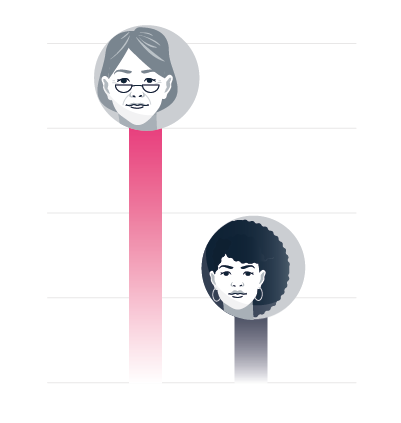
As a result of a declining mortality rate, improved healthcare, and better quality of life, human life expectancy has risen dramatically. When considering that global life expectancy is currently averaged at 73 years8 compared to just 52.5 years in 1960,9 this becomes even more evident.
Simultaneously, the average birth rate – the number of children a woman gives birth to – is on the decline. This rate currently sits at 2.4 (nearly half of what it was 60 years ago) and is forecasted to reach 1.7 in 2100.10 Should the global fertility rate fall below 2.1, as expected, the world population will decrease, resulting in an inverted age structure (more older adults than youths). Globally, in 2018, those aged 65 or over exceeded children younger than five for the first time.11
This increase in life expectancy, coupled with lower birth rates, has put immense pressure on traditional retirement and pension funds, with research indicating that most people will outlive their retirement savings by between eight and 20 years.12 Additionally, with the rising cost of living, retirement is also becoming more expensive. As a result, the current workforce isn’t able to retire at the same age that previous generations did. In the U.K., this has seen the default retirement age of 65 being abolished entirely, and employers can no longer force older workers to retire.13
The continued rise in the cost of living also means that members of Gen Z are opting to study longer and enter the workforce at a later stage – a trend that’s projected to continue for the next 20 years.14 The combined impact has implications for employers, who will need to shift existing beliefs and attitudes towards older workers.
The longevity dividend
With healthier, older employees unwilling – and largely unable – to retire, companies that use the aging workforce to address this societal concern are more likely to set themselves apart from their competitors.
However, this will create changes for employers that they would not have experienced with employing workers from only one or two generations. Varying degrees of skills among the generations will require the workforce to adapt their skill sets, with our research suggesting older generations need improved technical skills, and younger generations require interpersonal and leadership development.
There’s a notable association between increased rates of aging and increased rates of automation.15 Research shows that countries that have experienced aging more rapidly show a higher automation adoption rate. This supports the idea that a decline in a “prime-age” workforce forces companies to find alternative sources of productivity beyond local labor.
As we move towards higher levels of technological advancement and automation, technology will be designed with humans at the forefront. In the future, work will be less about using technology and more about interacting with technology. Therefore, technical skills will become the means by which to compete, and soft skills will become a competitive advantage. Older employees with these skills will become a more prominent source of labor, rather than risk being made redundant.
A shifting workplace: industry preferences
The increase in older employees hasn’t been seen equally across industries. Data from GetSmarter’s report shows that certain sectors are still dominated by a younger workforce.
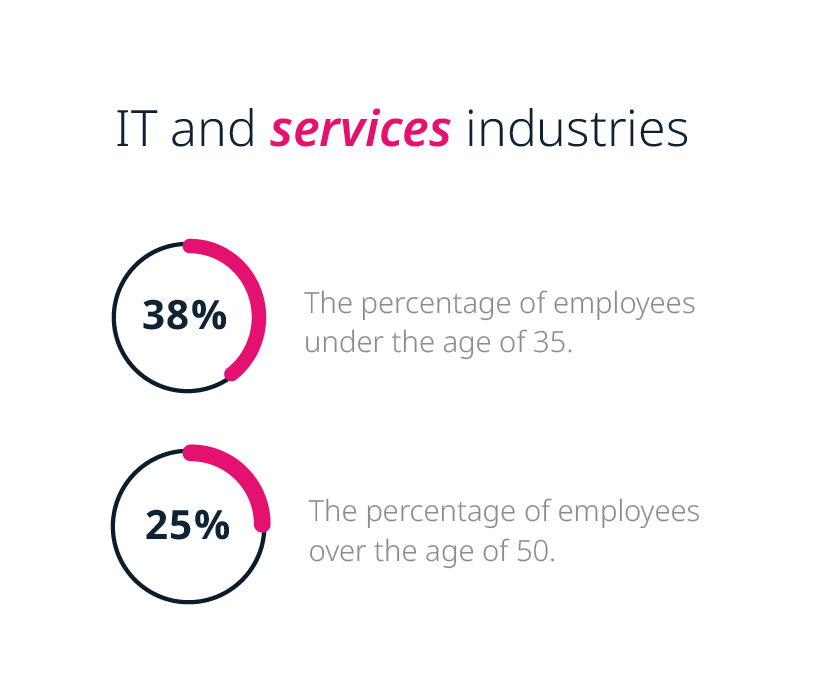
Ageism, in combination with other factors such as the perception that younger generations are more tech-savvy, may explain this skew towards a younger workforce in certain industries.
Younger generations are known to choose which industry they work in based on its perceived values. Companies in the tech industry are well known for establishing positive corporate values, appealing to younger generations.
On the other hand, younger generations attach a negative perception to industries such as oil and gas, defense, government, and public services. They’re therefore less inclined to work in these sectors, which is evident from GetSmarter’s research.
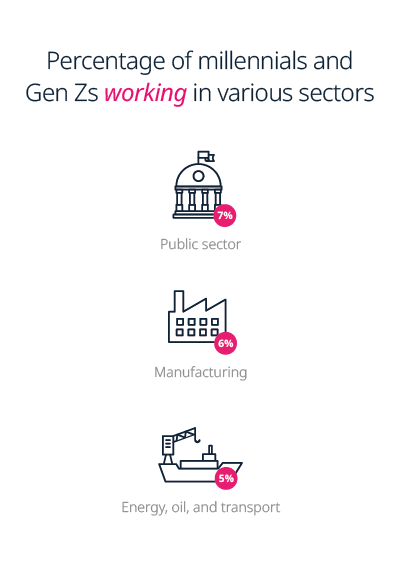
With employees who could be born more than five decades apart, today’s workforce is more complicated than ever. Technology has revolutionized our ability to perform various tasks virtually across continents and via multiple online platforms. Yet, the management systems, leadership practices, and communication processes that we use today are following routines established by a previous generation of workers, created in the Industrial Age.16 These assume that employees are prepared to commit a large percentage of their lives to their employers and fit their leisure, holidays, and family life around work. This outdated approach doesn’t comply with today’s principles of equality, freedom, and flexibility. To succeed, organizations now need to understand the various needs, values, and priorities that make up each generation and re-envision their management styles.
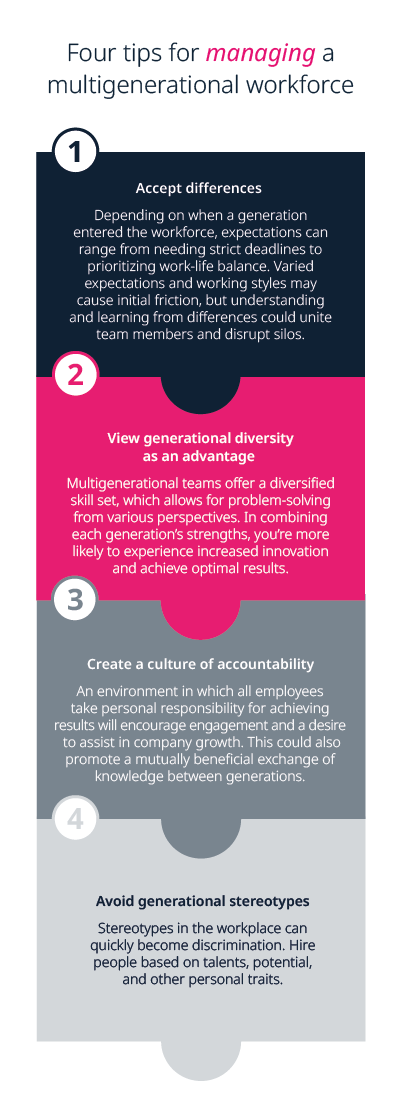
Organizations are also increasingly realizing the need to remain agile in the face of constant disruption. Change management offers organizations, and leaders, a way to respond to shifts in the workplace by putting a clear strategy in place. It’s the process that defines how an organization transitions from a current to a future state of operations in pursuit of value.
Gain the skills to achieve and nurture sustainable change in your organization in the Strategic Change Management online program from Kellogg School of Management at Northwestern University.
The impact of older generations working longer
Ageism and assumptions
“The vast majority of employers who offer any sort of diversity and inclusion training do not cover age. This goes right back to how age discrimination is viewed as the second-class civil right; it’s overlooked.”19
– Laurie McCann, senior attorney at AARP Foundation
While some governments have developed legislation that prohibits age discrimination in the workplace, ageism remains a significant problem. Ageism and generational stereotypes can make for an unpleasant experience, often pushing an older workforce to retire before they’re ready, or severely impacting their well-being. At the same time, employers can face discrimination lawsuits (some of which have costed companies between $2.85 million and $250 million),20 a demotivated workforce, and a loss of opportunity due to the devaluation of older employees.
The AARP workplace survey found that two out of three employees aged 45 or older experience ageism. Out of the 61 percent of respondents who reported age discrimination, 91 percent believed it was commonplace.21 Understanding and avoiding the assumptions that exist, being intentional about conversations around age and ageism, and investing in unconscious ageism training is a way forward in creating an inclusive workplace where everyone thrives.
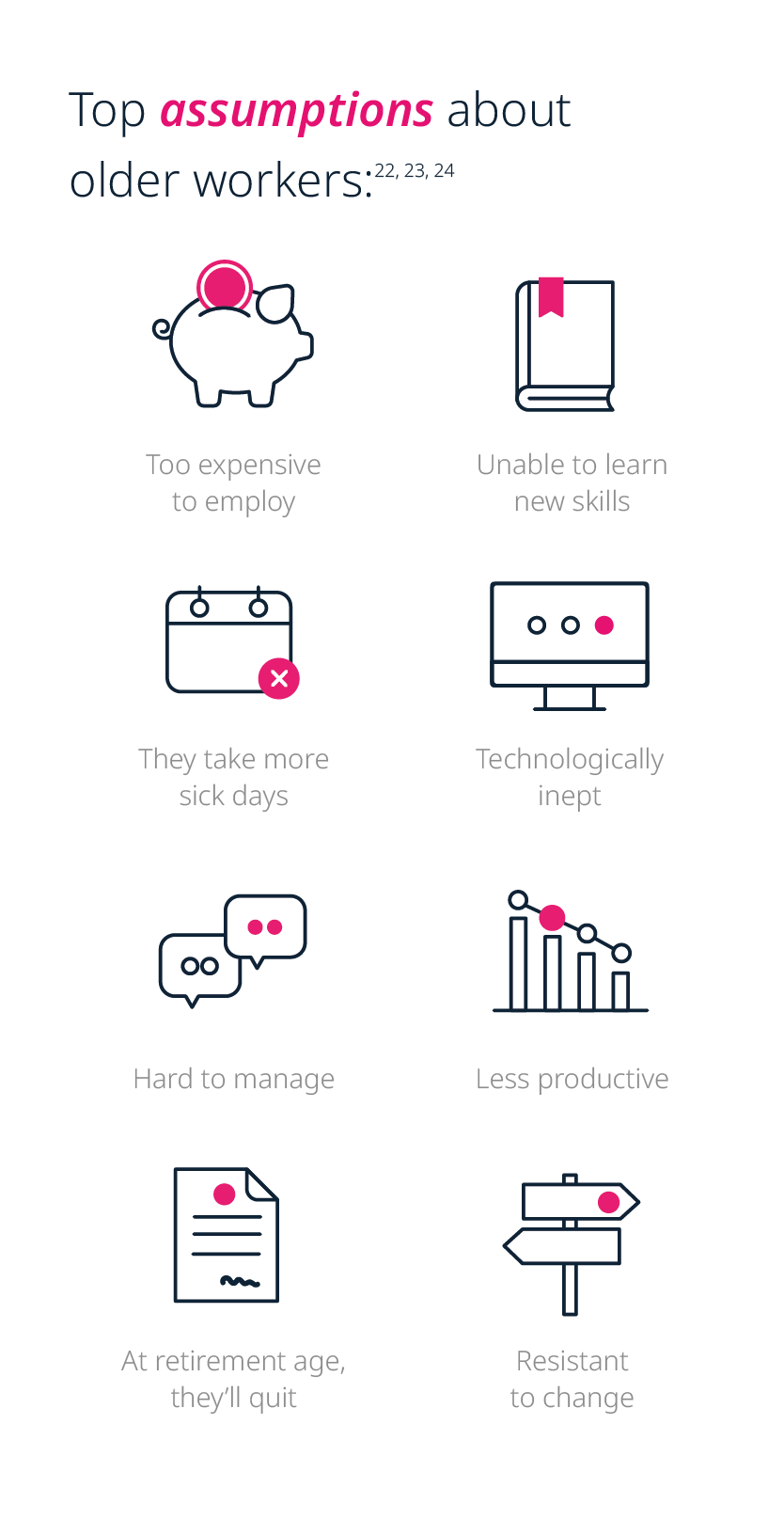
Companies who employ from a growing talent pool of older generational workers will have a better chance of managing skills gaps.25 Creating tools in which older employees and younger employees can share knowledge, as well as increasing the number of intergenerational teams in the workplace, can assist in reskilling and upskilling, and contribute to the fight against ageism.
Overcoming ageism in the workplace is vital to the future of work. Organizations need to put plans in place now to reduce prejudice and negative stereotypes about older workers to ensure business sustainability.
Younger generations are moving into management
According to GetSmarter’s research, a significant portion of younger generations are already in management and decision-making positions. They therefore have, and will continue to have, an important influence on the workplace.

Younger generations want meaningful work
Millennials and Gen Zs place greater pressure on themselves and their employers to find a job that’s meaningful.
According to a recent survey, 57 percent of millennials feel that it’s very important for their work to have a positive impact on the world, and 50 percent would consider taking a pay cut to be employed by a company they believe is making the world a better place.26 Similarly, Gen Z is one of the most socially active generations ever, with four out of five Gen Zs believing that their age group could change the world for the better.27 To attract younger employees, companies are focusing on corporate social responsibility and are actively pursuing these responsibilities, as younger generations will hold them accountable and expect transparency.
In addition to meaningful work, younger generations are also more vocal in their need for organizations to have strong corporate values and a company culture that facilitates employee happiness. A survey by Glassdoor found that, in the U.S. and U.K., younger adults are more likely to prioritize culture above salary, and 73 percent of all adults surveyed wouldn’t apply to a firm unless its values aligned to their own.28 Company culture has become a critical factor for young job seekers today. It also plays a role in whether they stay with a company, or move on. This has created a dynamic where employees have decision-making power over employers.
Young managers support flexibility
Younger generations’ demand for increased flexibility in the workplace, paired with better enabling technology, turbulent economic conditions, and uncertainty have given rise to an increasing number of remote workers and the growing “gig economy.” Both remote work and the gig economy can provide new job opportunities, improve earning potential, and offer parents the flexibility to work from home.
According to data from GetSmarter’s report, Generation Z managers are the most positive towards the gig economy. As shown by the graph below, nearly 16 percent of Gen Z managers said they’re hiring part-time contractors to fulfill specific skills gaps that exist in their organization. Additionally, Upwork found that younger-generation managers are more likely than their older counterparts to support flexibility in their teams by allowing remote work, and 50 percent of millennial and Gen Z managers have increased their use of freelancers in the past three years. In contrast, only 23 percent of baby boomers managers have done so.29
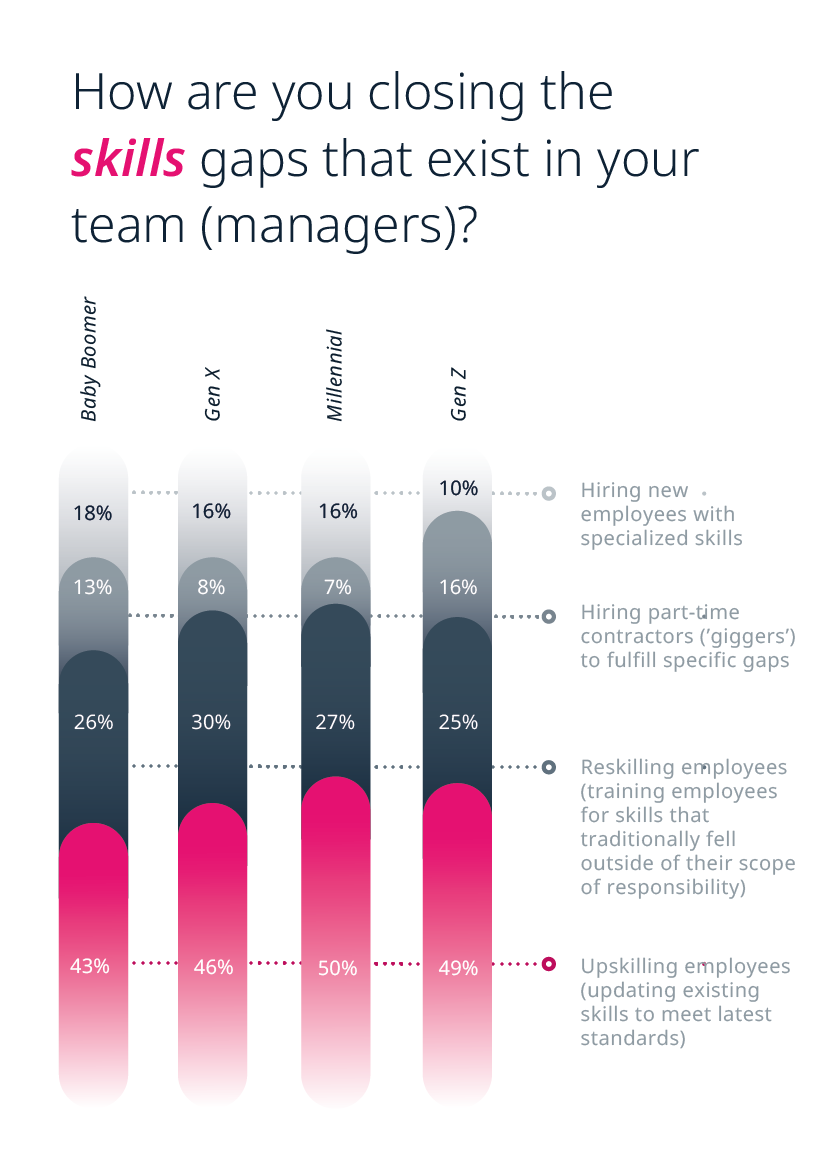
The value of continuous learning and skills-based certificate
Disruption and uncertainty, amplified by COVID-19, has had a dramatic impact on the business world, requiring professionals to refine their capabilities or risk falling behind. Now, more than ever, online learning is playing a vital role in ensuring skills development is more accessible and flexible.
According to GetSmarter’s research, 70 percent of respondents believe that skills-based certificates are currently a valuable signal of capability on a CV. This is especially true with Gen Zs and millennials. Furthermore, younger generations also believe that, with the increasing need to upskill and the rate of change in technology, skills-based certificates will become an increasingly valuable sign of capability on a CV in the next two years. As younger generations move up the corporate ladder, an online certificate will become a more acceptable form of education and signal of competence to employers.
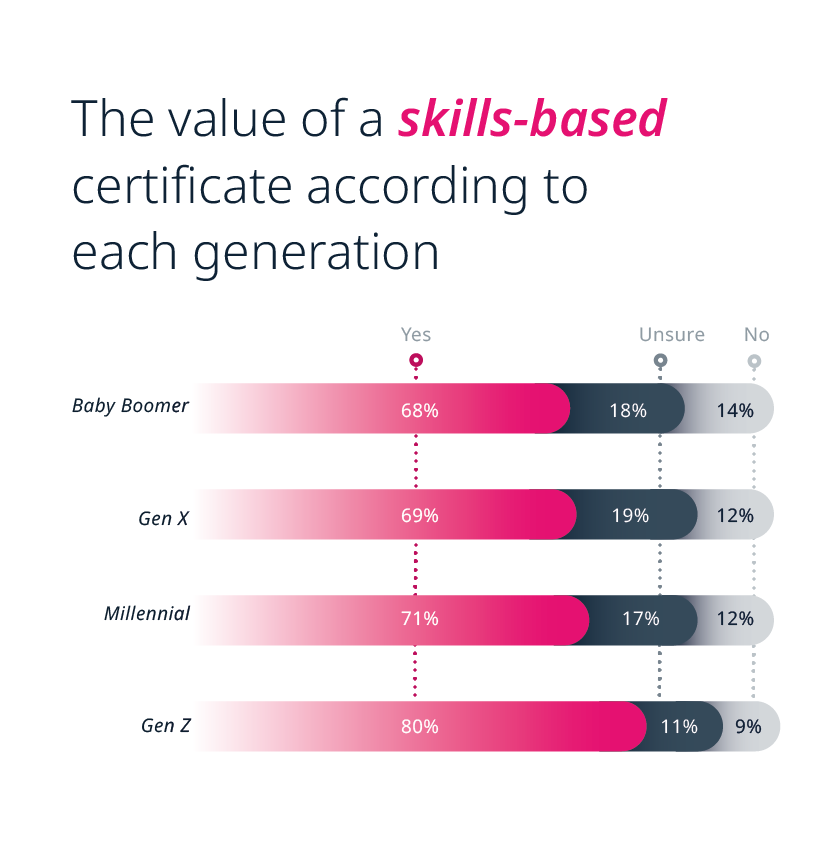
With younger generations already in management and decision-making positions, organizations are shifting away from the traditional workplace model of the past. They will continue to adapt as more Gen Zs enter the workforce.
The importance of diversity
There are many known benefits to having multigenerational teams working together, and research demonstrates that age diversity can improve performance. Through cognitive diversity and sharing workplace wisdom, age diversity can lead to more creative thinking and innovation.30 Younger workers tend to enjoy the insights, professionalism, and engaged work ethic that their older coworkers provide.31 Older employees also often display stronger relationship skills, which benefit the organization.32
By viewing age and generational differences as an opportunity, organizations can shift the focus to the abilities, experiences, and knowledge of individuals. Diversity can ultimately be a source of strength and innovation that leads to a happier, healthier, and more productive workforce.
Learn how to leverage diversity and inclusion to transform your business culture in the Inclusive Leadership online short course from EGADE Business School at Tecnológico de Monterrey, or gain practical tools to demonstrate the value of diversity, equity, and inclusion in your organization in the Leading Diversity, Equity, and Inclusion online short course from the Weinberg College of Arts and Sciences at Northwestern University.
While the business case for an age-diverse workforce is growing, employers need to navigate a host of new challenges in managing and supporting workers of all ages successfully. The age demographic shift has already started to disrupt the future of work drastically. The ability to adapt to an increasingly aging workforce and the changing values of younger generations will ensure professional and organizational success in an increasingly complex, competitive business environment.
Navigate the changing workforce effectively. Explore the rest of this series of blog articles related to the future of work here.
Stay competent, confident, and informed
Sign up to our monthly newsletter to receive the latest course information, expertise from renowned thought leaders, and a summary of our most recent blog articles.
- 1 Smith, M. (Nov, 2018). ‘Do generational differences really matter?’. Retrieved from Training Industry.
- 2 (2020). ‘Demographic shifts: the world in 2030’. Retrieved from Cushman & Wakefield.
- 3 Smith, M. (Nov, 2018). ‘Do generational differences really matter?’. Retrieved from Training Industry.
- 4 (2020). ‘Demographic shifts: the world in 2030’. Retrieved from Cushman & Wakefield.
- 5 (2020). ‘Demographic shifts: the world in 2030’. Retrieved from Cushman & Wakefield.
- 6 Merriman, M. (May, 2018). ‘Is your business ready for Gen Z?’ Retrieved from EY.
- 7 (2020). ‘Global talent trends’. Retrieved from Linkedin.
- 8 Roser, M. et al. (Oct, 2019). ‘Life expectancy’. Retrieved from Our World in Data.
- 9 (2019). ‘Life expectancy at birth, total (years)’. Retrieved from The World Bank.
- 10 Gallagher, J. (Jul, 2020).‘Fertility rate: “Jaw-dropping” global crash in children being born’. Retrieved from BBC.
- 11 Shibata, M. (Oct, 2019). ‘The untapped potential of the “longevity economy”’. Retrieved from BBC.
- 12 Wood, J. (Jun, 2019). ‘Retirees will outlive their savings by a decade’. Retrieved from the World Economic Forum.
- 13 Silkin, L. (Jan, 2020). ‘Changing demographics and ageing workforce’. Retrieved from Future of Work Hub.
- 14 Silkin, L. (Jan, 2020). ‘Changing demographics and ageing workforce’. Retrieved from Future of Work Hub.
- 15 (2018). ‘The twin threats of aging and automation’. Retrieved from Mecer.
- 16 Thomson, P. (Nd). ‘New ways of working in the company of the future’. Retrieved from OpenMInd BBVA.
- 17 Blakemore, K. (Apr, 2019). ‘3 Tips for leading a successful multigenerational Organization’ Retrieved from Inc.
- 18 (Jan, 2020). ‘Tips for leading a multigenerational workforce’. Retrieved from SimplicityHR.
- 19 Lindzon, J. (Mar, 2019). ‘The insidious effects of ageism in the workplace’. Retrieved from Fast Company.
- 20 Reiners, B. (Jul, 2020). ‘The cold, hard truth about ageism in the workplace’. Retrieved from Builtin.
- 21 Terrell, K. (Aug, 2018). ‘Age discrimination is common in the workplace, survey says’. Retrieved from AARP.
- 22 Janove, J. (Mar, 2019). ‘How to avoid ageism’. Retrieved from SHRM.
- 23 Twusami, R. et al. (Jul, 2018). ‘5 myths about older workers’. Retrieved from the World Economic Forum.
- 24 Jenkins, J. (Jan, 2019). ‘An ageing workforce isn’t a burden. It’s an opportunity’. Retrieved from the World Economic Forum.
- 25 Silkin, L. (Jan, 2020). ‘Changing demographics and ageing workforce’. Retrieved from Future of Work Hub.
- 26 (Sep, 2019). ‘Study: Millennials conflicted in the pursuit of meaningful work’. Retrieved from Olivet Nazarene University.
- 27 (Sep, 2019). ‘Study: Millennials conflicted in the pursuit of meaningful work’. Retrieved from Olivet Nazarene University.
- 28 (Jul, 2019). ‘Culture over cash? Glassdoor multi-country survey finds more than half of employees prioritize workplace culture over salary’. Retrieved from Glassdoor.
- 29 (2019). ‘Future Workforce Report’. Retrieved from UpWork.
- 30 Bersin, J. et al. (Sep, 2019). ‘The case for hiring older workers’. Retrieved from HBR.
- 31 (2020). ‘Global Talent Trends’. Retrieved from LinkedIn.
- 32 Schwartz, J. et al. (Dec, 2018). ‘No time to retire: Redesigning work for our aging workforce’. Retrieved from Deloitte.